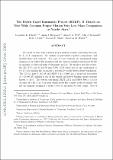The Brown Dwarf Kinematics Project (BDKP). II. Details on Nine Wide Common Proper Motion Very Low–Mass Companions to Nearby Stars
Author(s)
Faherty, Jacqueline K.; Burgasser, Adam J.; West, Adam J.; Bochanski, John J.; Cruz, Kelle L.; Shara, Michael M.; Walter, Frederick M.; ... Show more Show less
DownloadBurgasser_TheBrown.pdf (1.692Mb)
OPEN_ACCESS_POLICY
Open Access Policy
Creative Commons Attribution-Noncommercial-Share Alike
Alternative title
THE BROWN DWARF KINEMATICS PROJECT. II. DETAILS ON NINE WIDE COMMON PROPER MOTION VERY LOW MASS COMPANIONS TO NEARBY STARS
Terms of use
Metadata
Show full item recordAbstract
We report on nine wide common proper motion systems containing late-type M, L, or T companions. We confirm six previously reported companions, and identify three new systems. The ages of these systems are determined using diagnostics for both stellar primaries and low-mass secondaries and masses for the secondaries are inferred using evolutionary models. Of our three new discoveries, the M3+T6.5 pair G 204-39 and SDSS J1758+4633 has an age constrained to 0.5-1.5 Gyr making the secondary a potentially useful brown dwarf benchmark. The G5+L4 pair G 200-28 and SDSS J1416+5006 has a projected separation of ~25,000 AU making it one of the widest and lowest binding energy systems known to date. The system containing NLTT 2274 and SDSS J0041+1341 is an older M4+L0 (>4.5 Gyr) pair which shows Hα activity in the secondary but not the primary making it a useful tracer of age/mass/activity trends. Two of the nine systems have discrepant component ages that emerge from stellar or ultracool diagnostics indicating possible shortcomings in our understanding of the age diagnostics of stars and brown dwarfs. We find a resolved binary frequency for widely separated (>100 AU) low-mass companions (i.e., at least a triple system) which is at least twice the frequency found for the field ultracool dwarf population. The ratio of triples to binaries and quadruples to binaries is also high for this sample: 3:5 and 1:4, respectively, compared to 8 pc sample values of 1:4 and 1:26. The additional components in these wide companion systems indicates a formation mechanism that requires a third or fourth component to maintain gravitational stability or facilitate the exchange of angular momentum. The binding energies for the nine multiples discussed in this text are among the lowest known for wide low-mass systems, suggesting that weakly bound, low-to-intermediate mass (0.2 M sun < M [subscript tot]< 1.0 M sun) multiples can form and survive to exist in the field (1-8 Gyr).
Date issued
2010-01Department
MIT Kavli Institute for Astrophysics and Space ResearchJournal
Astronomical Journal
Publisher
American Astronomical Society
Citation
Jacqueline K. Faherty et al. “THE BROWN DWARF KINEMATICS PROJECT. II. DETAILS ON NINE WIDE COMMON PROPER MOTION VERY LOW MASS COMPANIONS TO NEARBY STARS,.” The Astronomical Journal 139.1 (2010): 176.
Version: Author's final manuscript
ISSN
1538-3881
0004-6256